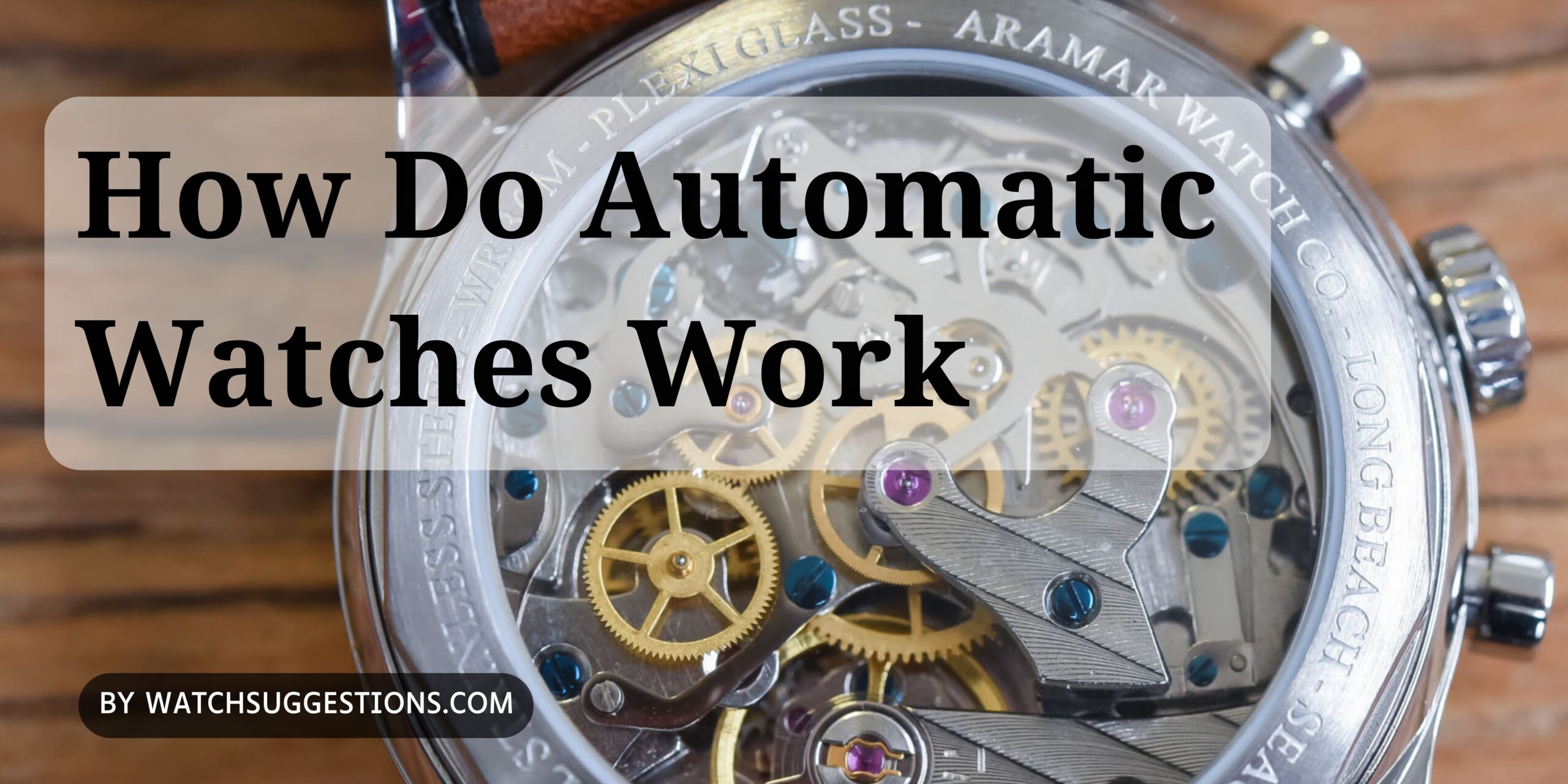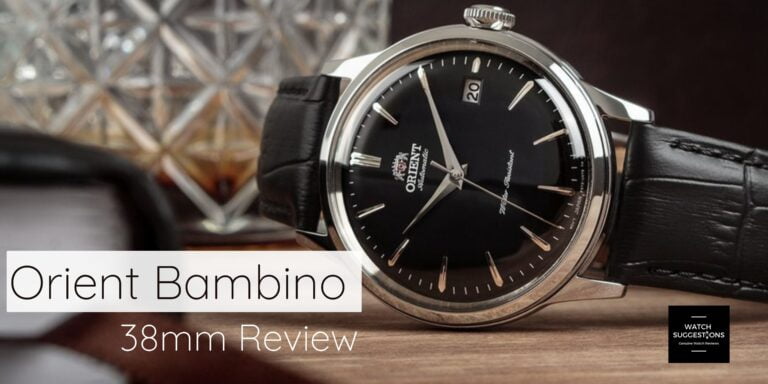How Do Automatic Watches Work? The Surprising Secret to Timeless Power

How do automatic watches work? This question comes to every newcomer’s mind.
If you are new to this topic. If you don’t know about automatic watches and their movements.
No need to worry, we’ve got your back
This article is all about How do automatic watches work and watch movements. So, in case you are a watch enthusiast looking for more information or a newcomer in the watch world.
You’ll get the answer to your question. So let’s turn up the dials of your watch knowledge.
What is a Caliber?
What drives these little movements and helps you stay on schedule?
Movements also called calibers, are the power that drives the motors of watches.
The main internal system that moves the hands of a watch is known as a caliber.
A movement, also called a caliber, is the power that runs the watch’s motor.
The chronograph, calendar, and dual time zones also work due to the small movement.
If you’re curious about how the crown and caliber work together to power a timepiece, we’ve broken it down in detail.
What is an Automatic Movement?
Watchmakers make various types of movements, usually with proprietary mechanisms.
Still, movements fall into two main categories:
1. Mechanical Movements
2. Quartz Movements.
“Hey, I don’t know which movement is quartz and which one is mechanical. So…” Many of you might have this question.
So, A simple way to tell if a movement is a quartz or mechanical look at the movement of the watch’s second hand.
In quartz watch movement shows the second-hand moves once per second. This shows a tick-tick movement.
A mechanical movement allows the second hand to move constantly. Here the second-hand moves with ease to mark the passing of seconds.
Both quartz and auto-quartz movements make use of a battery to help the working watch.
Mechanical watch movements are further divided into two categories:
1. Manual Movements
2. Automatic Movements.
A mechanical caliber consists of many small gears and springs inside the watch.
Mechanical watches are generally more expensive than battery-powered watches.
The reason is mechanical watches require more physical effort to manufacture.
Watches that work on batteries may show the correct time.
Usually, people choose automatic or hand-wound watches over battery-powered watches.
Automatic watches ate a symbol of hundred correctness and creativity in the watchmaking industry.
Automatic watches are also called self-winding watches. Even their movements are also called “self-winding” movements.
These calibers make use of the natural movements of the wearer’s wrist to power the watch.
Automatic watches are comfortable to wear, easy to use and simple to take care of.
They don’t need to be wound daily to make sure that the watch works and shows the correct time.
If the wearer wears the watch every day, then there is no need to hand-wind the watch to keep it working.
How do Automatic Watches Work?
Automatic movements use a rotor or metal weights to power the watch.
Inside the watch the rotor shifts in a simple. Each time the wearer moves their wrist, the rotor spins.
This rotational motion built inside the watch gets converted into energy.
This energy alone winds the watch’s mainspring while the mainspring stores power.
Do Automatic Watches still Need to be Wound?
In some cases, yes.
A watch with an automatic winding function that you wear every day is usually automatic.
But, if the wearer doesn’t wear the watch for some time, it will need to be wound to power the internal system.
Learn how to wind an automatic watch the right way so you don’t damage the mechanism.
History and Mystery of Automatic Watches
Harwood was behind the making of an automatic watch. The other watchmakers benefited from his success.
They started improving his original design. Rolex added extra weight to the watch.
This allows it to capture even more energy when worn.
Rolex watches can run for up to 35 hours thanks to their new and fashionable design.
In the late 1940s, Eterna Watch joined the sphere with its automatic watches.
These spheres helped for a more calm movement of the watch’s internal parts. This helped in making a more clear-cut and accurate watch.
Watches were also shown as being more sound in structure and durable.
What about Today’s Automatic Watches?
The most popular watches used by modern customers use automatic movements.
Yet there are few which use manual winding.
What are the main parts of an automatic watch?
Spring
The mainspring is the energy source of the self-winding movement. Sometimes An automatic watch needs to be hand-wound
When it is wound kinetic energy transfers to the coil spring.
As more energy gathers, the mainspring closes, storing more energy for later use.
Crown
At the side of the watch, there is a small gear called the crown. Turning the crown winds and moves the watch.
Gear Train
The energy stored in the mainspring passes through the train wheel. A series of tiny internal gears move the hands and other parts of the dial of the watch.
Escapement
An escapement is the brake system inside a watch.
The energy passed from the mainspring to the gear train is released in equal parts, known as the escapement.
Balance Wheel
A balance wheel is an internal part that vibrates in a circular motion 5 to 10 times per second.
Dial Train
A dial is another set of gears like a gear train.
The dial can transfer an equal part of the energy from the balance wheel to the hands of the watch, causing them to move.
Jewelry
The jewel is an artificial ruby set in the center of the gear this keeps the gear in continuous motion. It prevents the watch from heat and friction.
Rotor
A semi-circular metal weight in the watch is called a rotor.
The rotor attaches to the movement. It without any problem vibrates with the movement of the wearer’s wrist.
When the carrier moves and the rotor moves. The rotor transfers power to the mainspring, causing it to rotate, where energy gathers.
When the mainspring is wound, the clutch attached to the rotor engages.
If you wear your watch every day then automatic watches are the best. There will be times when the watch stops due to insufficient wear.
In such cases, you can consider using a watch winder for automatic watches to keep your timepiece running smoothly even when it’s not on your wrist.
At such times, shake the watch upwards until the hands start moving again but be gentle while shaking.
Or you can put it on and shake your wrist a few times. Once the hands start moving, you can set the date and time.
Always keep your watch dry and clean. Wipe the watch face with a soft cloth every night and avoid showering or bathing with your watch on.
Watches are water resistant, but watches usually cannot withstand high water temperatures.
Mechanism seals can stretch and shrink, reducing watch life and accuracy.
Automatic watches are amazing inventions that survived well in the digital era.
Buying Guide For An Automatic Watch
Look for these points. As they are important points to grade the quality of the movement.
Accuracy
The accuracy required for an automatic watch depends on the wearer. Some people need their watches to be very accurate.
For example, professional divers and military people need the most accurate watches. They use watches known as chronometer watches.
For those who choose style and convenience over everything. They can use the standard automatic watch.
This is a general rule for the accuracy of automatic watches which provides a ±25 second per day accuracy.
BHP
BHP refers to beats or ticks per hour. Watchmakers sometimes use the term beats per second or Hz. have a rate of pulsation.
A clock with a high beat makes the ticking clock run faster.
It reads less than 1 second, so it is more precise and accurate.
The movement of the second hand of the high-beat watch looks smooth.
Energy Reserve
A good wound automatic watch stores energy for up to 42 hours before needing to recharge again. Some automatic watch designs can have a power reserve of up to 10 days.
Complications
Complications perform functions other than telling the time.
In many automatic watch designs, there are various features.
The watch has a calendar date and a power reserve indicator, and can also activate an alarm function.
Reliability
Automatic watches are reliable watch designs. The watchmakers also gave thought to accuracy. Certain features improve the reliability and accuracy of the watch.
Automatic watches usually have a glass at the back so you can see the movement.
A well-executed movement has a good ticks time. In the case of a poorly-executed movement, it results in inconsistent scale measurements.
A watch made from poor-quality materials can lose you minutes a day.
Swiss, Japanese, and German watches are famous due to three things.
The highest quality material is used for exactness, accuracy, and reliability.
Why are watch collectors so drawn to automatic watches?
If automatic watches are more expensive, less accurate, and need more maintenance?
This choice depends on a lot of personal emotion. Several reasons include:
Automatic watches have an impressive achievement in engineering, There is an attractiveness to their mechanical character.
Automatic movements have a lot of physical effort and creativity behind them.
Many automatic watches have clear case backs. These case backs are made of sapphire.
This lets you see the automatic movement while it is working.
Isn’t it cool?
The second hand on a mechanical watch appears to move in a sweeping motion. Many people find the sweeping second-hand automatic watches amazing.
This is a sign that the watch gets its power from mechanical movement.
This is what fans of mechanical watches greatly appreciate.
Conclusion For Automatic Watch Movement
A movement, or caliber, is the force behind all the timekeeping functions of a watch.
These complex and precise movements are critical to the precision of the watch.
Internal movements are important for the working of automatic watches.
Most people buy these watches for aesthetics. People who love details and appreciate craftsmanship and correctness in a watch.
An automatic watch is perfect for you. With care and service, your beautiful automatic watch will last a lifetime.






